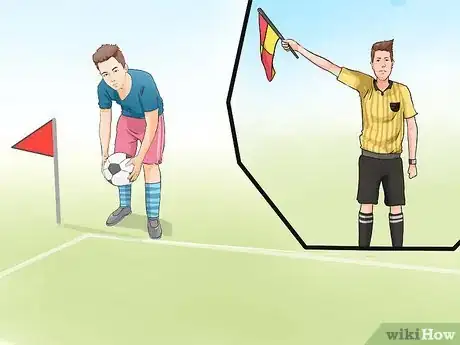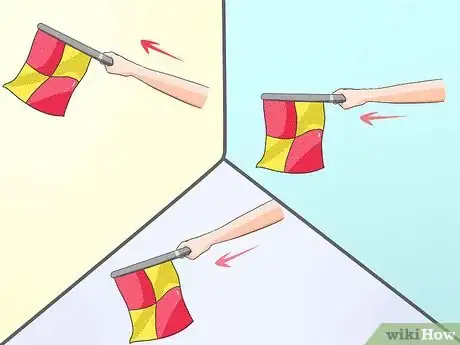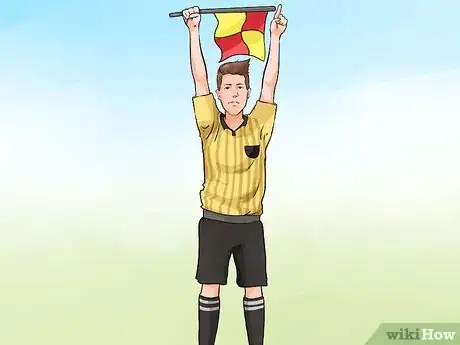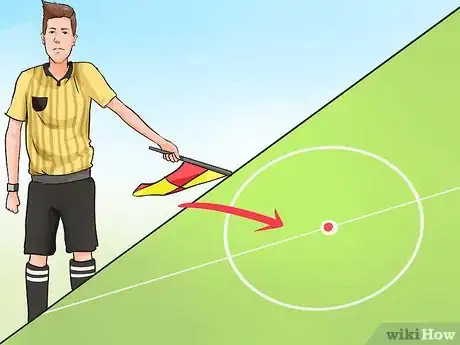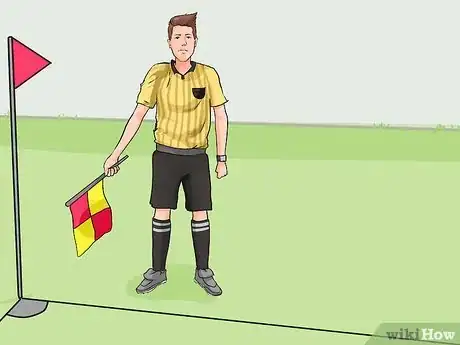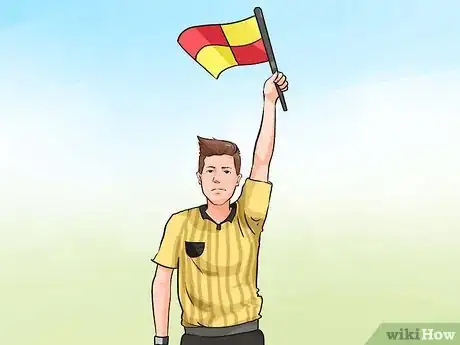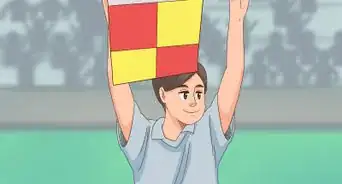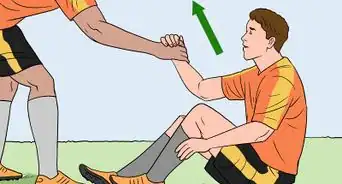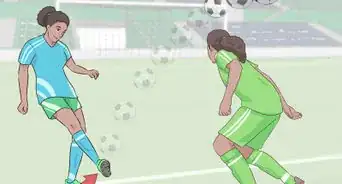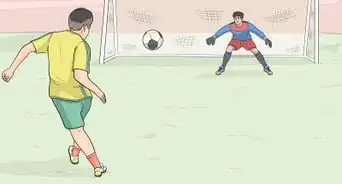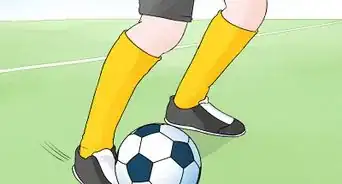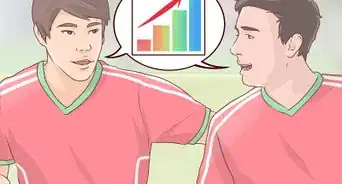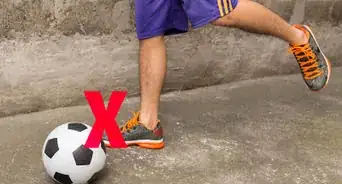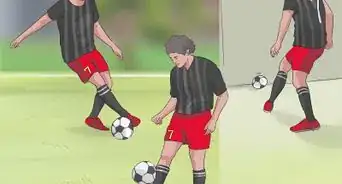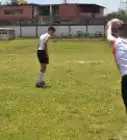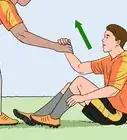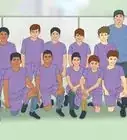X
wikiHow is a “wiki,” similar to Wikipedia, which means that many of our articles are co-written by multiple authors. To create this article, 35 people, some anonymous, worked to edit and improve it over time.
This article has been viewed 242,337 times.
Learn more...
On the field, the assistant referee's job is simple: assist the referee. Whether by calling an offside or directing a throw-in, the referee relies on the assistant's input. It is just as important to understand the assistant as it is to understand the referee, so here's a crash course in basic flag-waving.
Steps
-
1Watch for the flag up. This is the most basic signal the assistant will make. By putting the flag up, they are indicating to the referee that play needs to be stopped for some reason. Typically, when the assistant sees something, they will put up the flag, flick it to get the referee's attention (especially for a foul), and after the referee blows the whistle the assistant will indicate what they saw. If the referee does not see the flag, the other assistant will typically "mirror" the signal to help attract the referee's eye.[1]
-
2Watch for ball out-of-play and restarts. One of the two main jobs of the assistant is to indicate when the ball is out of bounds and how the game should proceed. Once the referee has blown the whistle, the assistant will indicate how to proceed:[2]
- If the assistant raises the flag, at a 45 degree angle and points it horizontally along the touch line, they are indicating for a throw-in. The team attacking in the direction they are pointing takes the throw.
- If the assistant stands near the goal line and points at the goal, they are signalling for a goal kick.
- If the assistant stands near the goal line and points at a downward 45 degree angle toward the corner flag, they are signalling for a corner kick.
Advertisement -
3Watch for offside. This is initially indicated by a flag straight up in the air, to indicate to the referee that play must be halted. When the referee's calls the offside with a whistle, the assistant then holds the flag in one of three positions in front of them to indicate where on the field the offside occurred and thus where the ball should be placed for the free kick. But if the referee gives you a waving gesture it means there was no advantage in play so it continues and you lower your flag.[3]
- If they hold the flag up at a 45 degree angle, they are signalling for an offside on the far side of the field (from them).
- If they hold the flag straight horizontally, they are signalling for an offside in the middle of the field.
- If they hold the flag down at a 45 degree angle, they are signalling for an offside on the near side of the field.
-
4Watch for substitutions. If the assistant holds his flag above his head with both hands, he is indicating to the referee that a substitution is being performed and that play should not be started until it is finished.[4]
-
5Watch for the goal signal. When the assistant thinks a goal has been scored, they will lower the flag, optionally may point to center with their hand and sprint back to the center line. If they want to dispute the goal, however, they will put the flag up and stay where they are.
-
6Watch for the penalty kick signal. The official signal is to raise the flag, flick it, then lower the flag, holding it horizontally across the waist (sometimes called, "skirting"). Many crews see this as too visible and will modify the signal. This can vary from region to region. Generally, if a foul is called by the referee and it is inside the penalty area the AR will move toward the corner flag. If the AR stays where they are then it indicates the foul was outside the penalty area. The referee can then determine the appropriate restart. Other possible signals for penalty kicks include holding the flag horizontally across the waist (without the initial flag raise and flick) or running to the corner flag and hiding their flag behind their back.[5]
-
7Watch for the miscellaneous signal. When the assistant simply keeps the flag straight up after the whistle is blown, he is indicating he needs to talk to the referee. The assistant may show this signal if, for example, a player begins abusing him or he sees outside interference. In particular, if he wishes to indicate that a player deserves a yellow or red card, he will place his hand over his chest badge.
Advertisement
Referee Hand Signals
Community Q&A
-
QuestionIf it is a throw to the home side, does the Lino point to the away keeper?
 Community AnswerYes. In the case of a throw in, you always point to the team that shot the ball over the line.
Community AnswerYes. In the case of a throw in, you always point to the team that shot the ball over the line. -
QuestionHow would I flag for a corner on far side of the pitch?
 Community AnswerSimply point to the corner closest to you. The referee and players will know to take the corner nearest to where the ball went out.
Community AnswerSimply point to the corner closest to you. The referee and players will know to take the corner nearest to where the ball went out. -
QuestionWhat is the difference between direct and indirect kicks? Should the linesman call that or is that up to the referee?
 Community AnswerThere is no distinct flag for an indirect vs direct kick. For either, the assistant should raise the flag, give it a flick, then point in the direction the kick should be taken. Indirect should probably be indicated verbally. The main example where this might happen is for a dangerous high kick near an opponent where no actual contact was made. This free kick would be indirect, meaning it would have to be touched by a player before going into the goal for that goal to count.
Community AnswerThere is no distinct flag for an indirect vs direct kick. For either, the assistant should raise the flag, give it a flick, then point in the direction the kick should be taken. Indirect should probably be indicated verbally. The main example where this might happen is for a dangerous high kick near an opponent where no actual contact was made. This free kick would be indirect, meaning it would have to be touched by a player before going into the goal for that goal to count.
Advertisement
Warnings
- Never, ever attempt to challenge the referee or the assistant. As far as the soccer game goes, they are always right, and arguing will just get you yellow-carded for dissent.⧼thumbs_response⧽
Advertisement
Things You'll Need
- a soccer game
- a referee
- assistant referee(s)
- flags
- Referee Outfit
- Watch
- Whistle
References
- ↑ http://www.sidelinesoccer.com/assistant-referee-signals
- ↑ https://www.youtube.com/watch?v=Hf8pRbPkOPs
- ↑ https://www.youtube.com/watch?v=Hf8pRbPkOPs
- ↑ http://news.bbc.co.uk/sport2/hi/football/rules_and_equipment/4995710.stm
- ↑ http://www.sidelinesoccer.com/assistant-referee-signals
- Offside Explained
About This Article
Advertisement

